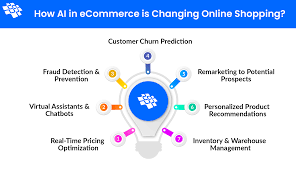How AI Is Changing E-Commerce: What Online Sellers Need to Do

How AI Is Changing E-Commerce: What Online Sellers Need to Do
Artificial intelligence (AI) is revolutionizing the e-commerce industry, reshaping how online businesses operate, engage customers, and optimize sales strategies. From personalized shopping experiences to automated customer support and predictive analytics, AI is no longer just a futuristic concept—it is the driving force behind modern e-commerce success. As AI-powered tools continue to evolve, online sellers must adapt to stay competitive and maximize their growth potential. In this blog, we will explore how AI is transforming e-commerce and what steps sellers need to take to leverage its benefits effectively.
AI-Driven Personalization in E-Commerce
One of the most significant ways AI is changing e-commerce is through personalized shopping experiences. AI analyzes customer data, including browsing history, purchase behavior, and preferences, to deliver highly targeted recommendations. Platforms like Amazon and Walmart use AI-powered recommendation engines to suggest products that align with customer interests, boosting conversion rates and average order value.
What Sellers Need to Do:
Implement AI-powered recommendation tools like Shopify’s AI product suggestions or Amazon’s personalized search algorithms.
Use AI-driven email marketing campaigns to send targeted promotions based on customer behavior.
Leverage AI chatbots to engage customers with tailored product recommendations in real time.
AI-Powered Chatbots and Virtual Assistants
Customer support is a critical component of e-commerce, and AI-driven chatbots are transforming how businesses handle inquiries. AI chatbots can answer common customer questions, assist with product searches, and even process orders 24/7, reducing response times and enhancing user experience.
What Sellers Need to Do:
Integrate AI chatbots like ChatGPT-powered customer support or Facebook Messenger bots to improve response efficiency.
Automate FAQs, order tracking, and basic issue resolution to reduce workload and enhance customer satisfaction.
Use AI-driven sentiment analysis to gauge customer emotions and improve support interactions.
AI in Predictive Analytics and Demand Forecasting
AI-powered predictive analytics helps e-commerce businesses make data-driven decisions by analyzing historical data and market trends. AI can forecast demand fluctuations, optimize pricing strategies, and prevent stockouts or overstocking.
What Sellers Need to Do:
Utilize AI tools like Google’s AutoML, Amazon Forecast, or Walmart Luminate to analyze customer trends.
Adjust pricing dynamically using AI-powered repricing tools like RepricerExpress or Feedvisor.
Optimize inventory management by predicting demand spikes and seasonal shopping trends.
AI in Fraud Prevention and Security
As e-commerce transactions increase, so do fraud risks. AI is playing a crucial role in detecting fraudulent activities by analyzing transaction patterns and identifying suspicious behavior. Machine learning algorithms flag fraudulent orders before they are processed, reducing chargebacks and financial losses.
What Sellers Need to Do:
Implement AI fraud detection solutions like Signifyd, Riskified, or Amazon’s fraud protection systems.
Monitor transaction patterns and set AI-powered alerts for unusual activities.
Use biometric authentication and AI-driven identity verification to enhance security.
AI for Automated Content Creation and SEO Optimization
AI is streamlining content creation, helping e-commerce sellers generate SEO-optimized product descriptions, blog posts, and ad copies effortlessly. AI-powered tools analyze keyword trends and generate high-ranking content that enhances search engine visibility.
What Sellers Need to Do:
Use AI-driven content tools like Jasper AI, Copy.ai, or Frase to generate high-quality product descriptions.
Optimize product listings using AI-driven SEO suggestions based on search trends.
Leverage AI-powered A/B testing tools to identify the most effective ad copies and headlines.
AI-Powered Image and Video Recognition
Visual search is gaining popularity in e-commerce, with AI-powered image recognition allowing customers to search for products using images instead of text. Retail giants like Amazon, eBay, and Pinterest are using AI-driven visual search to enhance the shopping experience.
What Sellers Need to Do:
Optimize product images for AI-powered search engines like Google Lens.
Use AI-driven video content tools to create engaging product demonstrations and ads.
Implement AI-powered augmented reality (AR) solutions to offer virtual try-ons or 3D product previews.
The Future of AI in E-Commerce
AI is continuously evolving, with new advancements emerging in voice commerce, autonomous delivery, and hyper-personalization. As AI becomes more sophisticated, e-commerce sellers must stay ahead of trends to remain competitive. Voice-activated shopping through AI assistants like Alexa and Google Assistant is on the rise, and businesses need to optimize for voice search to capture this growing market.
Final Thoughts
AI is no longer an option but a necessity in modern e-commerce. By leveraging AI-powered tools for personalization, automation, security, and analytics, online sellers can enhance customer experiences, improve efficiency, and drive more sales. As AI continues to shape the future of online retail, embracing these technologies will be crucial for long-term success. Sellers who adapt early will gain a competitive edge, ensuring sustainable growth in the ever-evolving e-commerce landscape of 2025 and beyond.





